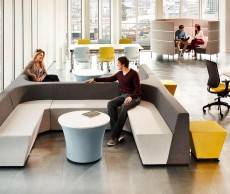
It’s become commonplace in recent years for certain people to foresee the death of the office. The problem with this argument is that, in spite of its drawbacks, office life maintains an attraction for both employers and employees and there will always be an upper limit on how long people want to spend away from other people. Things are changing but the death of the office is a myth. As we’ve known for at least a quarter of a century, there is no absolute need for us to go to work at all. Theoretically we could just do away with offices completely if we wanted to. But as we have seen, the fact we have evolved technology to the point where we could forget about bricks and mortar, doesn’t necessarily mean we will. Not only are there practical reasons for offices to continue to exist, there are emotive ones too. If you want evidence of this, look no further than the records currently being set by the UK’s commercial property markets.
According to a new report published by Lambert Smith Hampton, a record breaking £64.3bn, was invested in UK commercial property last year, up 4 percent from 2014. What is particularly interesting, according to the report, is that asset management and office refurbishment will be vitally important in 2016, because they drive rental income for investors, especially in areas where there are few vacant offices.
One other report published in January emphasis just how important offices are for the UK economy. According to the study from the British Property Federation, commercial real estate represents over a fifth of total net wealth in the UK, worth £1,662bn, contributing over 5 percent to net GDP and underpins the pensions of around seven million people.
Although this wealth tends to be focussed on London, it certainly isn’t confined to it. Indeed, a recent report from Savills shows that many firms are looking at alternatives to the capital as they seek to keep costs down and access new pools of talent. The study claims that rising property costs in central London could lead to a wave of businesses relocating outside the capital. According to Savills, the average cost of an employee has risen to more than £50,000 a year in central London, compared with an average of £33,695 in the rest of the UK. This cost in London includes just over £35,000 in wages, but an additional £15,000 per work station in rents, rates and service charges. The property costs in London are three times what they are in the regions outside the UK capital.
So it’s perhaps no surprise to learn that other regions are thriving too. For example, Birmingham now ranks as the highest UK city for investment prospects in a new report published by the Urban Land Institute (ULI) and accountancy and advisory firm PwC. The 2016 Emerging Trends in Real Estate Europe 2016: Beyond the Capital report – says the city set to benefit from substantial infrastructure investment, in particular the HS2 high-speed rail line to London scheduled to open in 2026.
Birmingham’s relative value is also bringing occupiers to its office market, with global bank HSBC moving its retail division to the city, taking a 20,000 sq m pre-let at 2 Arena Central. In addition, rising rents and a dwindling supply of good quality space have prompted several developers to start building or refurbishing their offices.
According to a recent survey from CBRE, other UK core cities that continue to attract investment in offices include Bristol (£1.9 billion over ten years) and Cardiff (£734 million). Anecdotally, we understand that the trend in these areas is again to create exceptional offices to attract occupiers and the people they would like to employ. That is now the key challenge for employers in a world in which it is possible to work form anywhere. How to create an office environment that is more attractive than its alternatives. The death of the office may be a myth, but its continuing survival depends on it evolving into a truly exceptional space in which to get things done.
___________________________________
 Paul Goodchild is the Design Director of Fresh Workspace. Main image Connection.
Paul Goodchild is the Design Director of Fresh Workspace. Main image Connection.














February 5, 2016
What the commercial property market tells us about trends in office design 0
by Paul Goodchild • Comment, Property, Workplace design
It’s become commonplace in recent years for certain people to foresee the death of the office. The problem with this argument is that, in spite of its drawbacks, office life maintains an attraction for both employers and employees and there will always be an upper limit on how long people want to spend away from other people. Things are changing but the death of the office is a myth. As we’ve known for at least a quarter of a century, there is no absolute need for us to go to work at all. Theoretically we could just do away with offices completely if we wanted to. But as we have seen, the fact we have evolved technology to the point where we could forget about bricks and mortar, doesn’t necessarily mean we will. Not only are there practical reasons for offices to continue to exist, there are emotive ones too. If you want evidence of this, look no further than the records currently being set by the UK’s commercial property markets.
According to a new report published by Lambert Smith Hampton, a record breaking £64.3bn, was invested in UK commercial property last year, up 4 percent from 2014. What is particularly interesting, according to the report, is that asset management and office refurbishment will be vitally important in 2016, because they drive rental income for investors, especially in areas where there are few vacant offices.
One other report published in January emphasis just how important offices are for the UK economy. According to the study from the British Property Federation, commercial real estate represents over a fifth of total net wealth in the UK, worth £1,662bn, contributing over 5 percent to net GDP and underpins the pensions of around seven million people.
Although this wealth tends to be focussed on London, it certainly isn’t confined to it. Indeed, a recent report from Savills shows that many firms are looking at alternatives to the capital as they seek to keep costs down and access new pools of talent. The study claims that rising property costs in central London could lead to a wave of businesses relocating outside the capital. According to Savills, the average cost of an employee has risen to more than £50,000 a year in central London, compared with an average of £33,695 in the rest of the UK. This cost in London includes just over £35,000 in wages, but an additional £15,000 per work station in rents, rates and service charges. The property costs in London are three times what they are in the regions outside the UK capital.
So it’s perhaps no surprise to learn that other regions are thriving too. For example, Birmingham now ranks as the highest UK city for investment prospects in a new report published by the Urban Land Institute (ULI) and accountancy and advisory firm PwC. The 2016 Emerging Trends in Real Estate Europe 2016: Beyond the Capital report – says the city set to benefit from substantial infrastructure investment, in particular the HS2 high-speed rail line to London scheduled to open in 2026.
Birmingham’s relative value is also bringing occupiers to its office market, with global bank HSBC moving its retail division to the city, taking a 20,000 sq m pre-let at 2 Arena Central. In addition, rising rents and a dwindling supply of good quality space have prompted several developers to start building or refurbishing their offices.
According to a recent survey from CBRE, other UK core cities that continue to attract investment in offices include Bristol (£1.9 billion over ten years) and Cardiff (£734 million). Anecdotally, we understand that the trend in these areas is again to create exceptional offices to attract occupiers and the people they would like to employ. That is now the key challenge for employers in a world in which it is possible to work form anywhere. How to create an office environment that is more attractive than its alternatives. The death of the office may be a myth, but its continuing survival depends on it evolving into a truly exceptional space in which to get things done.
___________________________________